Belkin F6D3050 Wireless A/G USB Adapter User Manual F6D3050 rev
Belkin International, Inc. Wireless A/G USB Adapter F6D3050 rev
Belkin >
Contents
- 1. Users manual
- 2. Users mnual
Users manual

BELKIN Wireless A+G USB Network Adapter
Connect your desktop or notebook
computer to a FAST wireless network
User Manual
Table of Contents
1
Introduction . . . . . . . . . . . . . . . . . . . . . . . . . . . . …………………………………
…………..…………….. . . . . . .1
Benefits of a Home
Network. . . . . . . . . . . . . . . . . . . ………………………………………... . . . . . . . . . .
1
Advantages of setting up a Belkin Wireless
Network . . . . . …………………………………………. . . . . 1
Placement of your Wireless Networking
Hardware for Optimal
Performance . . . . . . . . . . . . . . . . . ………………………………………… . . . . . . 2
Important Factors for Placement and
Setup . . . . . . . . . . . . …………………………………………. . . . . 2
Features . . . . . . . . . . . . . . . . . . . . . . . . . . . . . . . . . . . . …………
……………………………. . . . . . . . . . 6
Applications and
Advantages . . . . . . . . . . . . . . . . . . . …………………………………………. . . . . . . . .
6
Product
Specifications . . . . . . . . . . . . . . . . . . . . . . . . . . ………………………………………... . . . . . . .
7
System
Requirements . . . . . . . . . . . . . . . . . . . . ………………………………………… . . . . . . . . . . . . .
7
2 Knowing your Wireless USB Network
Adapter . . . . . ……………………………………………………. . . . . .8
3 Installing and Setting Up the USB Network
Adapter . . . ……………………………………………………. . . .9
Step 1: Install the
Software . . . . . . . . . . . . ………………………………………………………… . . . . . . .9
Step 2: Connect your USB Adapter to your PC . ……………………………………………………….. . .
10
Step 3: Let Windows Finish the
Installation . . . ……………………………………………………….. . . . 11
4 Uninstalling the Software and
Drivers. . . . . . . . . . ……………………………………………………... . . . . . 13
5 Using the Belkin Wireless LAN Monitor
Utility . . . ……………………………………………………… . . . . . 14
6 Securing your Wireless
Network . . . . . . . . . . . . ………………………………………………………. . . . . . . 26
7
Troubleshooting . . . . . . . . . . . . . . . . . . . . . ………………………………………………
……….. . . . . . . . . . 30
8
Information. . . . . . . . . . . . . . . . . ………………………………………………………... . .
. . . . . . . . . . . . . . . 37
..

Introduction
Thank you for purchasing the Belkin Wireless A+G USB Network Adapter (the Adapter). Now you can take advantage
of this great new technology and gain the freedom you need around the home or office without using cables. The
Wireless USB Network Adapter works like a conventional network adapter, but without the wires. The easy installation
and setup will have you networking wirelessly in minutes. Please be sure to read through this User Manual completely,
and pay special attention to the section entitled “Placement of your Wireless Networking Hardware for Optimal
Performance” on page 2. By following our simple setup instructions your Belkin Home Network will allow you to:
• Share one high-speed Internet connection with all the computers in your home
• Share resources, such as files, and hard drives among all the connected computers in your home
• Share a single printer with the entire family
• Share documents, music, video, and digital pictures
• Store, retrieve, and copy files from one computer to another
• Simultaneously play games online, check Internet e-mail, and chat
Here are some of the advantages of setting up a Belkin
Wireless Network:
• Mobility – you’ll no longer need a dedicated “computer room”—now you can work on a networked laptop or
desktop computer anywhere within your wireless range
• Easy installation – Belkin Easy Installation Wizard makes setup simple
• Flexibility – set up and access printers, computers, and other networking devices from anywhere in your home
• Easy Expansion – the wide range of Belkin networking products let you expand your network to include devices
such as printers and gaming consoles
• No cabling required – you can spare the expense and hassle of retrofitting Ethernet cabling throughout the
home or office
• Widespread industry acceptance – choose from a wide range of interoperable networking products

Introduction
Placement of your Wireless Networking Hardware for
Optimal Performance
Your wireless connection will be stronger the closer your computer is to your Wireless Router (or Access Point).
Typical indoor operating range for your wireless devices is between 100 and 200 feet. In the same way, your wireless
connection and performance will degrade somewhat as the distance between your Wireless Router (or Access Point)
and connected devices increases. This may or may not be noticeable to you. As you move further from your Wireless
Router or Access Point, connection speed may decrease. Factors that can weaken signals simply by getting in the
way of your network’s radio waves are metal appliances or obstructions, and walls. If you have concerns about
your network’s performance that might be related to range or obstruction factors, try moving the computer to
a position between five and ten feet from the Wireless Router, in order to see if distance is the problem. If
difficulties persist even at close range, please contact Belkin Technical Support.
IMPORTANT FACTORS FOR PLACEMENT AND SETUP
Note:
While some of the items listed below can affect network performance, they will not prohibit your wireless
network from functioning; if you are concerned that your network is not operating at its maximum effectiveness,
this checklist may help.
1. Placement of your Wireless Networking Hardware
Place your Wireless Router (or Access Point), the central connection point of your network, as close as possible
to the center of your wireless network devices.
To achieve the best wireless network coverage for your “wireless clients” (i.e., computers enabled by Belkin
Wireless Notebook Network Cards, Wireless Desktop Network Cards, and Wireless USB Adapters):
• Ensure that your Wireless Router (or Access Point) networking antennas are parallel to each other, and are
positioned vertically (toward the ceiling). If your Wireless Router (or Access Point) itself is positioned
vertically, point the antennas as much as possible in an upward direction.

Introduction
• In multistory homes, place the Wireless Router (or Access Point) on a floor that is as close to the center
of the home as possible. This may mean placing the Router on an upper floor.
• Try not to place the Wireless Router (or Access Point) near a cordless 2.4GHz phone.
2. Avoid Obstacles and Interference
Avoid placing your Wireless Router or Access Point near devices that may emit radio “noise”, such as microwave
ovens. Dense objects that can inhibit Wireless communication can include:
• Refrigerators
• Washers and/or dryers
• Metal cabinets
• Large aquariums
• Metallic-based UV tinted windows
If your wireless signal seems weak in some spots, make sure that objects such as these are not blocking the signal’
s path (between your computers and Wireless Router or Access Point)
3. Cordless Phone Placement
If the performance of your wireless network is impaired after attending to the above issues, and you have a cordless
phone:
• Try moving cordless phones away from Wireless Routers (or Access Points) and your wireless-enabled computers
• Unplug and remove the battery from any cordless phone that operates on the 2.4GHz band (check manufacturers
information). If this fixes the problem, your phone may be interfering.
• If your phone supports channel selection, change the channel on the phone to the furthest channel from your
wireless network, as possible. For example, change the phone to channel 1 and move your Wireless Router to channel
11. See your phone’s user manual for detailed instructions.
• If necessary, consider switching to a 900MHz cordless phone.

Introduction
4. Choose the “quietest” channel for your wireless network
In locations where homes or offices are close together, such as apartment buildings or office complexes, there
may be wireless networks nearby that can conflict with yours. Use the Site Survey capabilities of your Wireless
LAN Utility to locate any other wireless networks (see page 16 of this manual), and move your Wireless Router
(or Access Point) and computers to a channel as far away from other networks as possible.
Experiment with more than one of the available channels, in order to find the clearest connection and avoid
interference from neighboring cordless phones or other wireless devices.
5. Secure connections, VPNs, and AOL
Secure connections are connections that typically require a user name and password, and are used where security
is important. Secure connections include:
• Virtual Private Network (VPN) connections, often used to connect remotely to an office network
• The “Bring Your Own Access” program from America Online (AOL), which lets you use AOL through broadband
provided by another cable or DSL service
• Most on-line banking websites
• Many commercial websites which require a user name and password to access your account
Secure connections can be interrupted by a computer’s power management setting, which causes it to “go to sleep.”
The simplest solution to avoid this is to simply reconnect by re-running the VPN or AOL software, or by re-logging
into the secure web site.
A second alternative is to change your computer’s power management settings so it does not go to sleep; however,
this may not be appropriate for portable computers. To change your power management setting under Windows, see
the “Power Options” item in the Control Panel.

Introduction
If you continue to have difficulty with Secure Connection, VPNs and AOL please review steps 1-4 above to be sure
you have addressed these issues.
These guidelines should allow you to cover the maximum possible area with your Wireless Router. Should you need
to cover an even wider area, please go to the networking product section on (www.belkin.com/networking) for more
details on Belkin’s Wireless Range Extender/Access Point.
For more information regarding our networking products, visit our website at www.belkin.com/networking or call
our Technical Support.

Introduction
Product Features
The adapter complies with the IEEE 802.11a and 802.11g standards in order to communicate with other 802.11a- and
802.11g-compliant wireless devices at 108Mbps. The adapter is compatible with 802.11b devices at 11Mbps. 802.11g
and 802.11b products operate on the same 2.4GHz frequency and 802.11a operates on the 5.0GHz band.
• Integrated 802.11g and 802.11a wireless technology
• 2.4GHz ISM (Industrial, Science, and Medical) and 5.0GHz band operation
• 108 A+G Technology achieves data rates up to 108Mbps
• XR Technology doubles the coverage area compared to standard 802.11g and 802.11a networks.
• Integrated easy-to-use Wireless Network Utility
• USB 2.0 interface, for operation in virtually any notebook ordesktop computer
• WPA, 64-bit WEP (Wired Equivalent Privacy), 128-bit encryption, and 802.1x authentication
• Wireless access to networked resources
• Support for both Infrastructure (Access Point) and Ad-Hoc (peer-to-peer)
• Easy installation and use
• LED power and network link indicators
Applications and Advantages
• Wireless roaming with a laptop around the home or office
Offers the freedom of networking—without cables
.• Compatible with 802.11b
802.11g wireless LAN solutions are backward-compatible with existing Wi-Fi (802.11b) products and with other
802.11g products.
• Difficult-to-wire environments
Enables networking in buildings with solid or finished walls, or open areas where wiring is difficult to install.
• Frequently changing environments
Adapts easily in offices or environments that frequently rearrange or change locations.

Introduction
• Temporary LANs for special projects or peak time
Sets up temporary networks such as at trade shows, exhibitions, and constructions sites, which need networks on
a short-term basis; also companies who need additional workstations for a peak activity period.
• SOHO (Small Office/Home Office) networking needs
Provides the easy and quick small network installation SOHO users need.
Product Specifications
Host Interface: USB 2.0
This product is compatible with the USB 1.1 and USB 2.0 specification. To achieve maximum networking speeds (54Mbps),
this device must be connected to a USB 2.0 host port on a PC. Connection of this device to a USB 1.1 host port
will yield a maximum of 11Mbps networking speed.
Power Consumption: Tx/Rx peak 490/290 @ 5V (max)
Certification: FCC Class B, CE Mark, C-Tick
Operating Temperature: 0 – 40° C
Storage Temperature: -20 – 80°
Operating Humidity: 10% – 85% non-condensing
StorageHumidity: 5% - 90% non-condensing°
System Requirements
• PC with one available USB port
• Windows® 2000, or XP
Package Contents
• Belkin Wireless USB Network Adapter with Desktop Stand
• Quick Installation Guide
• Installation Software CD
• User Manual
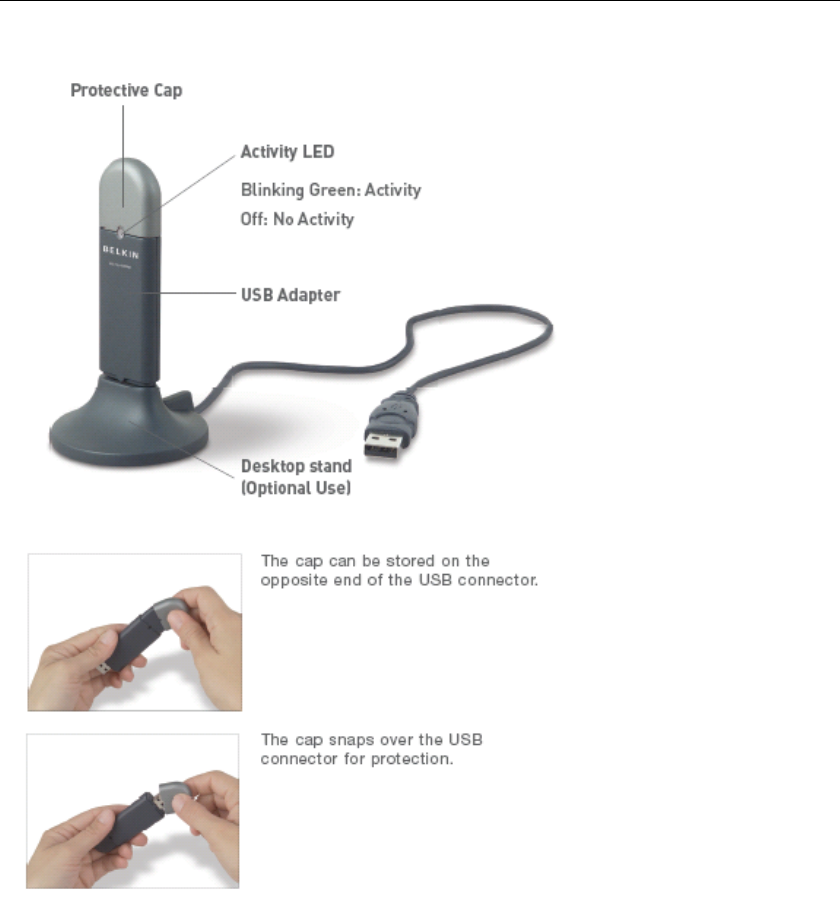
Knowing your Wireless USB Network Adapter
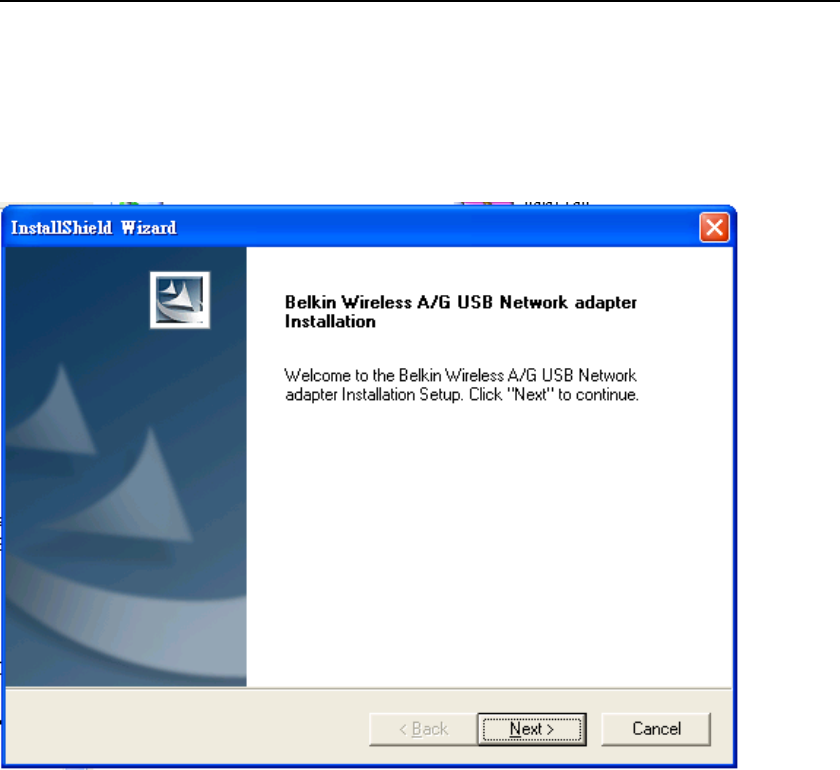
Installing and setting up the USB Network Adapter
Step 1 Install the Software
WARNING: Install the software before inserting the Adapter
1.1 Insert the CD into your CD-ROM drive.
1.2
The Belkin Wireless USB Network Adapter Setup Utility screen will automatically appear. If it does not appear
within 15–20 seconds, then select your CD-ROM drive and double-click on the folder named “Files”. Next
double-click on the icon named “setup.exe”.
1.3 In the menu window, drag your mouse over the “Install” button then select “Click here” to start the
software installation program.
1.4 The installer will start. Click “Next” to continue.
1.5 Choose an installation location then click “Next” to accept the default location or click “Browse”
to select a different location before clicking “Next.”

Installing and setting up the USB Network Adapter
1.5 You will see a message twice similar to the one below during the installation process. This DOES NOT mean
there is a problem. Click “Continue Anyway” each time the warning message is encountered..
Installing and setting up the USB Network Adapter

Step 2 Connect the USB Adapter to your PC2.1
After the software installation is finished, the message “You
can plug in your WLAN adapter now” will appear. Plug the Adapter into an available USB port on your desktop or
notebook computer.
Product Placement
The best location for your adapter is on top of your computer’s monitor. Placing the Adapter on your desktop
is acceptable, however, avoid placing the Adapter near metal objects such as a computer case or speakers. Any
object that is metal has the ability to block the radio signals from the Adapter
.

Installing and setting up the USB Network Adapter
Step 3 Let Windows Finish the Installation
3.1 After connecting your Adapter, Windows will detect that new hardware has been installed. Depending on your
version of Windows, a window similar to the one pictured here will appear. Select the option “Install the software
automatically (Recommended)” and click “Next”.
3.2 You will see a warning message twice similar to this one. This DOES NOT mean there is a problem. Click “Continue
Anyway” each time the warning message is encountered..
3.3 You will see a window similar to this one. Click “Finish”.

3.4 Double-click on the “Signal Indicator” icon located in the lower right corner of your screen (in the system
tray) to bring up the Wireless Network Utility

Uninstalling the Software and Drivers
If you need to remove the software and drivers for any reason, you can easily accomplish this in one of two ways.
You can insert the software CD and click on the “Uninstall” option in the menu, or you can go to the Windows
Control Panel and select the “Add/Remove Programs” option. The Belkin Wizard will walk you through the removal
process.
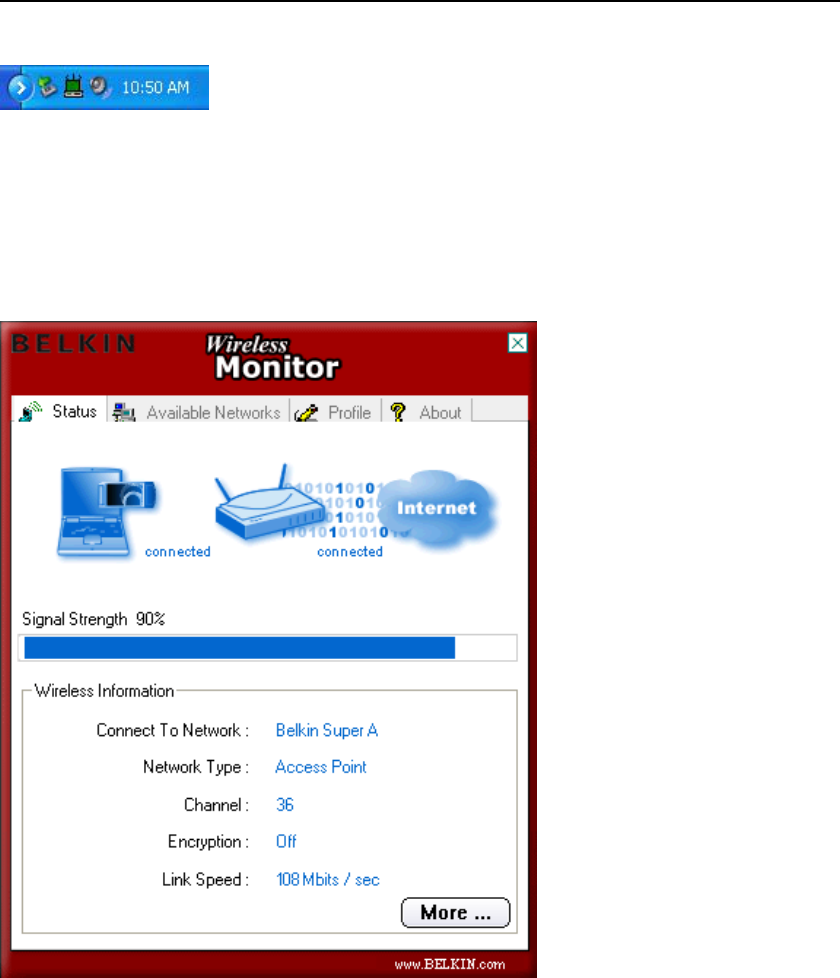
Using the Belkin Wireless LAN Monitor Utility
When you launch the Wireless LAN Monitor Utility (the Utility), you will be presented with the screen below. The
following small icon will also be present in your system tray.
Double-clicking on the icon in the system tray will open the Wireless Monitor window.
USING THE BELKIN WIRELESS MONITOR UTILITY
Status Tab
When the utility is on your desktop, you can control your USB adapter through the utility. The first tab you will
see is the “Status” tab. From this tab you can see your current connection status on the screen. The example
below shows that there is a connection between the computer and the Wireless Router (or Access Point) by displaying
1’s and 0’s between the two. The diagram below also shows there is a connection between your computer, the Wireless
Router (or Access Point), and the Internet by displaying 1’s and 0’s between the Wireless Router (or Access
Point) and the Internet.
If there is no connection between the computer and Wireless Router (or Access Point), an “X” will be displayed.
This is the same for the Internet connection.

Using the Belkin Wireless LAN Monitor Utility
(a) Signal Strength
Displays the signal strength of the related router (or access point).
(b) Connect to Network
Displays the current network SSID, the network name of the router (or access point) you are connected to.
(c) Network Type
Displays either “Infrastructure” if connected to a router (or access point) or “Ad-Hoc” when connected to another computer.
(d) Channel
Displays the channel the network is on.
(e) Encryption
Displays “Off” when encryption is disabled, “WEP” when either 64-bit or 128-bit is enabled, or “WPA” when WPA is enabled.
(f) Link Speed
Displays the data rate of the current connection.
(g) More…
Clicking the “More…” button lets you see detailed specifics about the network you are connected to such as DHCP Status, Current IP,
Subnet Mask, Default Gateway and DNS Server IP information.
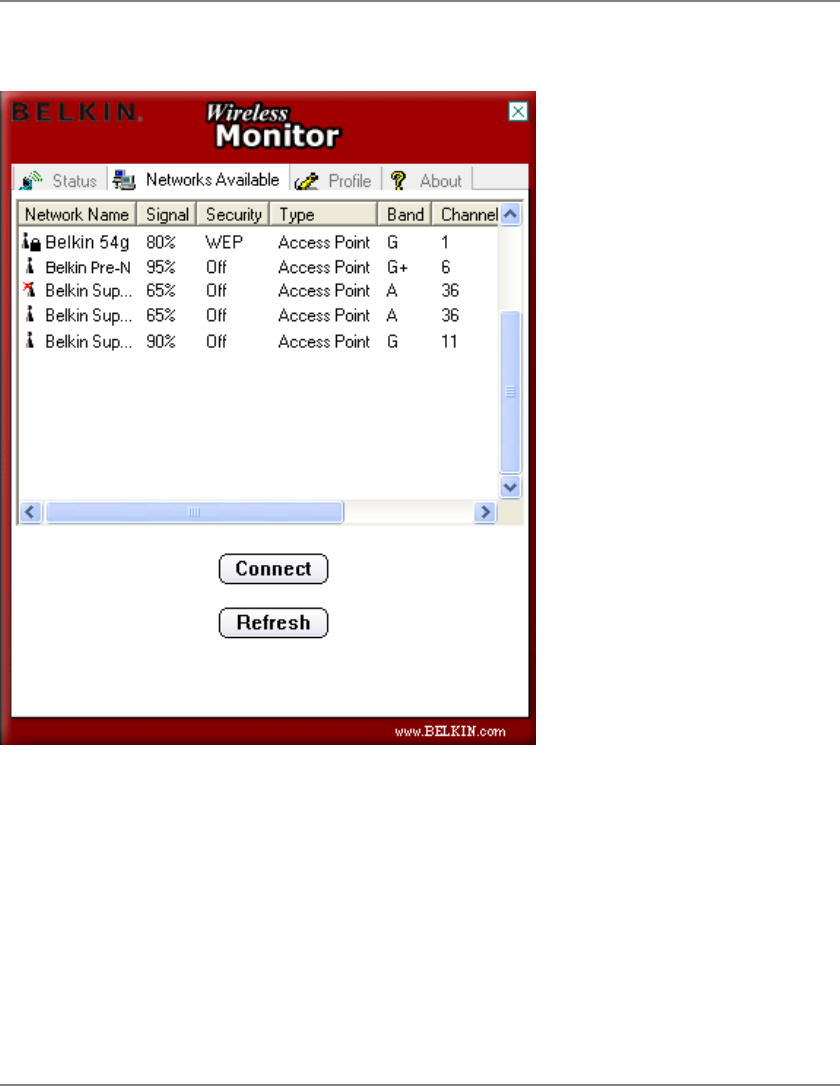
Using the Belkin Wireless LAN Monitor Utility
Network Available Tab
Click on the Available Networks tab to display a list of all available wireless routers (and/or access
points) in your area. To connect to an available network, click on the network you would like to connect
to from the “Available Networks” list, and then click on the “Connect” button.
(a) Network Name
The SSID of the router or access point.
(b) Signal
The signal strength of the related router (or access point).
(c) Security
Will display “Off” when encryption is disabled, “WEP” when either 64-bit or 128-bit is enabled, or “WPA” when WPA is enabled.
(d) Type
Will display the network type of either “Infrastructure” if connected to a router (or access
point) or “Ad-Hoc” when connected to another computer.
Using the Belkin Wireless LAN Monitor Utility
(e) Band
The wireless band the network is on.
(f) Channel
The wireless channel the network is using.
(g) Mac Address
The Mac address of the router or access point.
(h) Connect
Connects to the selected network.
(i) Refresh
Refreshes the status of the networks in the area.
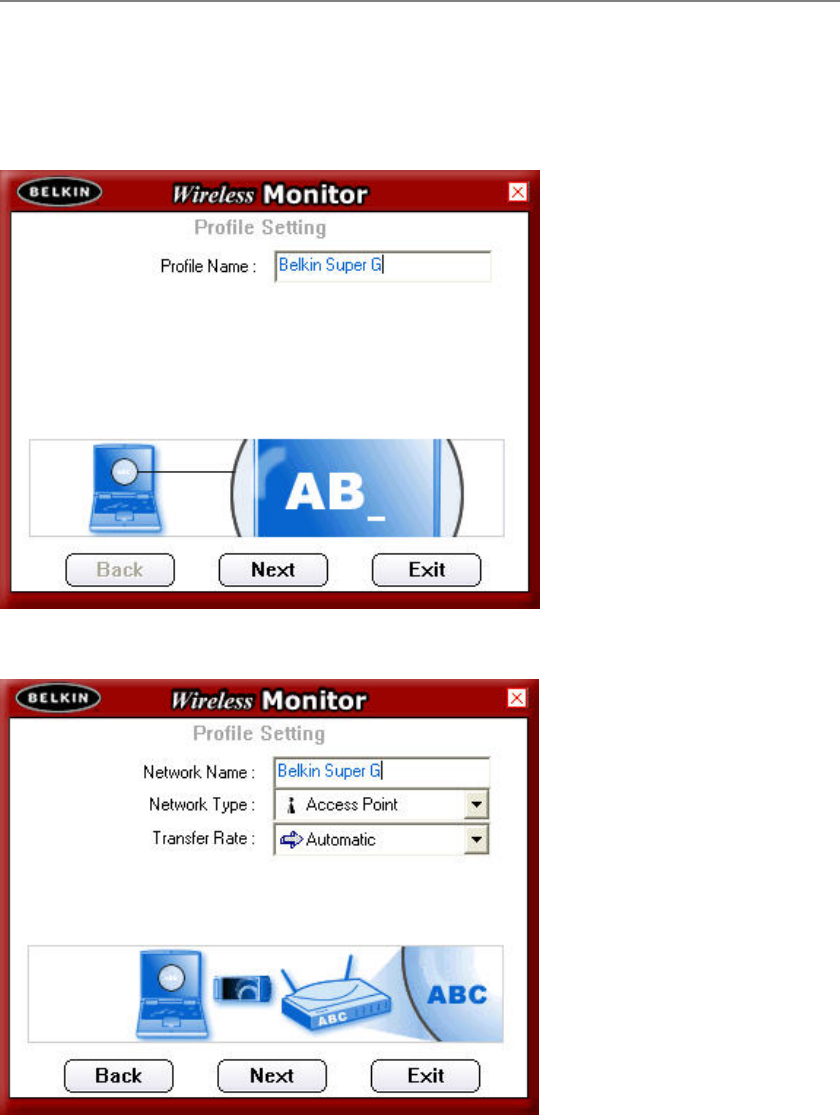
Using the Belkin Wireless LAN Monitor Utility
Profile Tab: Creating a Profile
Using Profiles allows you to save configurations for different wireless networks, for instance at home or at work without having to
reconfigure your connection each time you connect. This allows you to quickly change from one profile to another profile without
having to remember the particular settings of a certain network.
Step 1. To create a new wireless network profile, click on the “Profiles” tab. Click “Add” to open the new profile screen. Type in a name
for the profile. You should pick something easy to remember like “Work” for your work network or “Home” for your home network.
Click “Next” to continue.
Step 2. The next screen you will see allows you to type in the name of the network you will be connecting to, the type of network it is,
and optionally, you can set the data rate for that network. After making the selections, click “Next” to continue.
(a) Network Name
The exact name of the network you will be connecting to. The “Network Name” is the same as the network SSID.
(b) Network Type
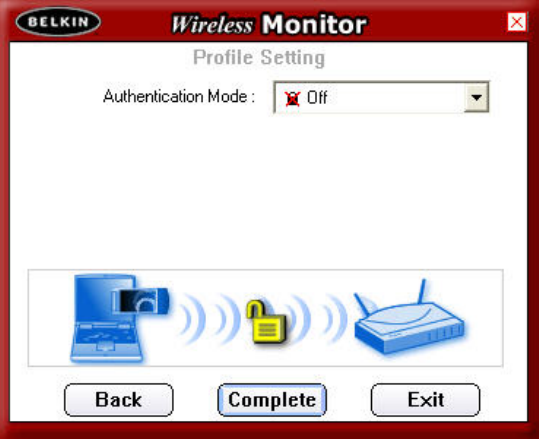
Select either “Access Point”, if it is a network with a wireless router or access point, or “Peer-to-Peer” if this is a direct connection to
another computer.
(c) Transfer Rate
“Automatic” is the suggested “Transfer Rate” unless there is a specific need to change this setting.
Step 3. The next screen allows you to input security encryption settings for the network. If the network you are connecting to is not
encrypted, leave the “Authentication Mode” in “Off” and click the “Complete” button to save the profile. If your network is encrypted,
please see page __ to continue.
(3010-u10.jpg)
Step 4. To begin using your new profile, highlight the profile name by clicking on the name one time, then click “Connect”.
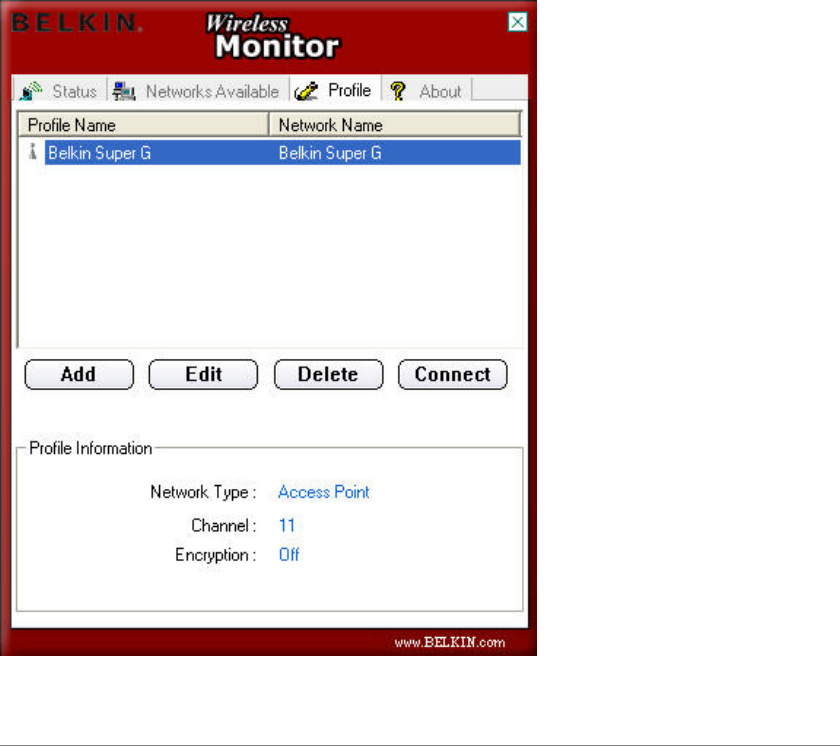
Using the Belkin Wireless LAN Monitor Utility
Securing your Wi-Fi Network
Here are a few different ways to maximize the security of your wireless network and protect your data from unwanted intrusion. This
section is intended for the home, home office, and small office user. At the time of publication, three encryption methods are available.
Encryption Methods:
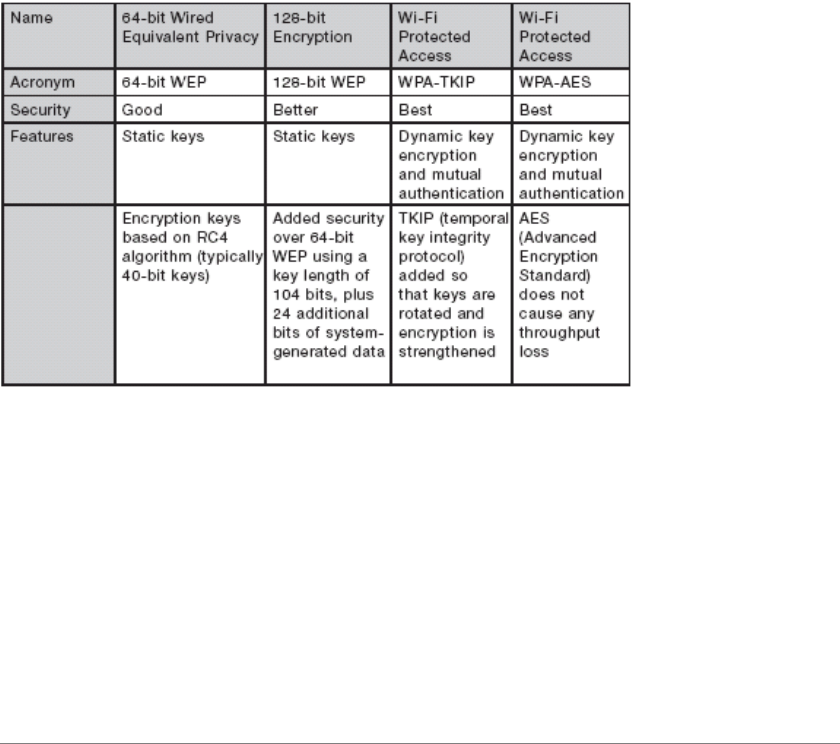
Wired Equivalent Privacy (WEP)
WEP is a common protocol that adds security to all Wi-Fi-compliant wireless products. WEP gives wireless networks the equivalent
level of privacy protection as a comparable wired network.
64-Bit WEP
64-bit WEP was first introduced with 64-bit encryption, which includes a key length of 40 bits plus 24 additional bits of system
generated data (64 bits total). Some hardware manufacturers refer to 64-bit as 40-bit encryption. Shortly after the technology was
introduced, researchers found that 64-bit encryption was too easy to decode.
128-Bit Encryption
As a result of 64-bit WEP’s potential security weaknesses, a more secure method of 128-bit encryption was developed. 128-bit
encryption includes a key length of 104 bits plus 24 additional bits of system-generated data (128 bits total). Some hardware
manufacturers refer to 128-bit as 104-bit encryption.
Most of the new wireless equipment in the market today supports both 64-bit WEP and 128-bit WEP encryption, but you might have
older equipment that only supports 64-bit WEP. All Belkin wireless products will support both 64-bit WEP and 128-bit encryption.
Using the Belkin Wireless LAN Monitor Utility
Encryption Keys
After selecting either the 64-bit WEP or 128-bit encryption mode, it is critical that you generate an encryption key. If the encryption key
is not consistent throughout the entire wireless network, your wireless networking devices will be unable to communicate with one
another.
You can enter your key by typing in the hex key. A hex (hexadecimal) key is a mixture of numbers and letters from A–F and 0–9. For
64-bit WEP, you need to enter 10 hex characters. For 128-bit WEP, you need to enter 26 hex characters.
For instance:
AF 0F 4B C3 D4 = 64-bit WEP key
C3 03 0F AF 0F 4B B2 C3 D4 4B C3 D4 E7 = 128-bit key
Write down the hex WEP key from your wireless router or access point and enter it manually into the hex WEP key table in your
adapter’s configuration screen.
Wi-Fi Protected Access (WPA)
WPA is a new Wi-Fi standard that improves upon the security features of WEP. To use WPA security, the drivers and software of your
wireless equipment must be upgraded to support it. These updates will be found on your wireless vendor’s website. There are two types
of WPA security: Wi-Fi Protected Access-Pre-Shared Key (WPA-PSK), typically for use in home-network configurations when not
operating on a radius server; and WPA (with radius server), typically for office-network configurations.
WPA-PSK (no server) uses what is known as a pre-shared key as the network key. A network key is a password that is between eight
and 63 characters long. It can be a combination of letters, numbers, or characters. Each client uses the same network key to access the
network. Typically, this is the mode that will be used in a home environment.
WPA (with radius server) is a system in which a radius server distributes the network key to the clients automatically. This is typically
found in a business environment.
For a list of Belkin wireless products that support WPA, please visit our website at www.belkin.com/networking.
Most wireless products ship with security turned off. So once you have your network working, you may need to activate WEP or WPA
and make sure all your wireless devices are sharing the same network key.
The following diagram shows the effect of not having the correct network key throughout your network.
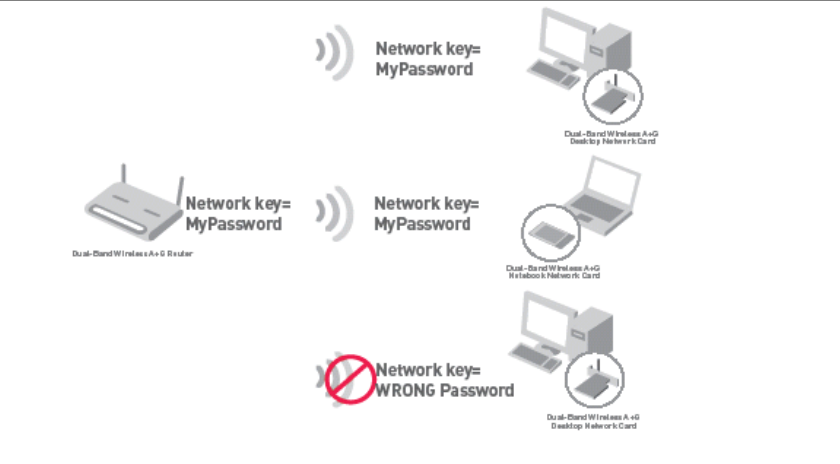
Using the Belkin Wireless LAN Monitor Utility
Setting Up your Belkin Wireless Router (or Access Point) to Use Security
To start using security, you need to first enable WEP or WPA for your wireless router or access point. For the Belkin Wireless Router (or
Access Point) these security features can be configured by using the web-based interface. See your Wireless Router (or Access Point)
User Manual for directions on how to access the management interface.
Changing the Wireless Security Settings
The Belkin Wireless G Router and Belkin G Range Extender/Access Point are equipped with the latest WPA security feature. They also
support the legacy WEP security standard. By default, wireless security is disabled.
To enable security, you will need to determine which standard you want to use. To access the security settings, click “Security” on the
wireless section using the web-based interface. (Please see your wireless router or access point manual for directions on how to access
the security settings.)

Using the Belkin Wireless LAN Monitor Utility
WEP Setup
64-Bit WEP Encryption
1. Select “64-bit WEP” from the drop-down menu.
2. After selecting your WEP encryption mode, you can enter your key by typing in the hex key manually, or you can type in a passphrase
in the “Passphrase” field and click “Generate” to create a key.
A hex (hexadecimal) key is a mixture of numbers and letters from A–F and 0–9. For 64-bit WEP, you need to enter 10 hex characters.
For instance:
AF 0F 4B C3 D4 = 64-bit WEP Key
3. Click “Apply Changes” to finish. Encryption in the wireless router or access point is now set. Each of your computers on your wireless
network will now need to be configured with the same security settings.
WARNING: If you are using a wireless client to turn on the security settings in your wireless router or access point, you will
temporarily lose your wireless connection until you activate security on your wireless client. Please record the key prior to applying
changes in the wireless router or access point. If you don’t remember the hex key, your client will be locked out of the wireless router or
access point.
128-Bit WEP Encryption
1. Select “128-bit WEP” from the drop-down menu.
2. After selecting your WEP encryption mode, you can enter your key manually by typing in the hex key manually, or you can type in a
passphrase in the “Passphrase” field and click “Generate” to create a key.
A hex (hexadecimal) key is a mixture of numbers and letters from A–F and 0–9. For 128-bit WEP, you need to enter 26 hex characters.
For instance:
C3 03 0F AF 0F 4B B2 C3 D4 4B C3 D4 E7 = 128-bit WEP key
3. Click “Apply Changes” to finish. Encryption in the wireless router or access point is now set. Each of the computers on your wireless
network will now need to be configured with the same security settings.
WARNING: If you are using a wireless client to turn on the security settings in your wireless router or access point, you will
temporarily lose your wireless connection until you activate security on your wireless client. Please record the key prior to applying
changes in the wireless router or access point. If you don’t remember the hex key,
your client will be locked out of the wireless router or access point.
Using the Belkin Wireless LAN Monitor Utility
WPA-PSK (no server)
Choose this setting if your network does not use a radius server. WPA-PSK (no server) is typically used in home and small office
networking.
1. From the “Security Mode” drop-down menu, select “WPA-PSK (no server)”.
2. Enter your network key. This can be from eight to 63 characters and can be letters, numbers, or symbols. This same key must be used
on all of the clients (network adapters) that you want to include in your wireless network.
3. Click “Apply Changes” to finish. You must now set all clients (network adapters) to match these settings.
WPA (with server) Settings
Choose this setting if your network uses a radius server to distribute keys to the clients (network adapters). WPA (with server) is
typically used in business networks.
1. From the “Security Mode” drop-down menu, select “WPA (with Radius Server)”.
2. Enter the IP address of the radius server into the “Radius Server” fields.
3. Enter the radius key into the “Radius Key” field.
4. Enter the key interval. The key interval is how often the keys are distributed (in packets).
5. Click “Apply Changes” to finish.
IMPORTANT: You must now set all wireless network adapters/adapters to match these settings.
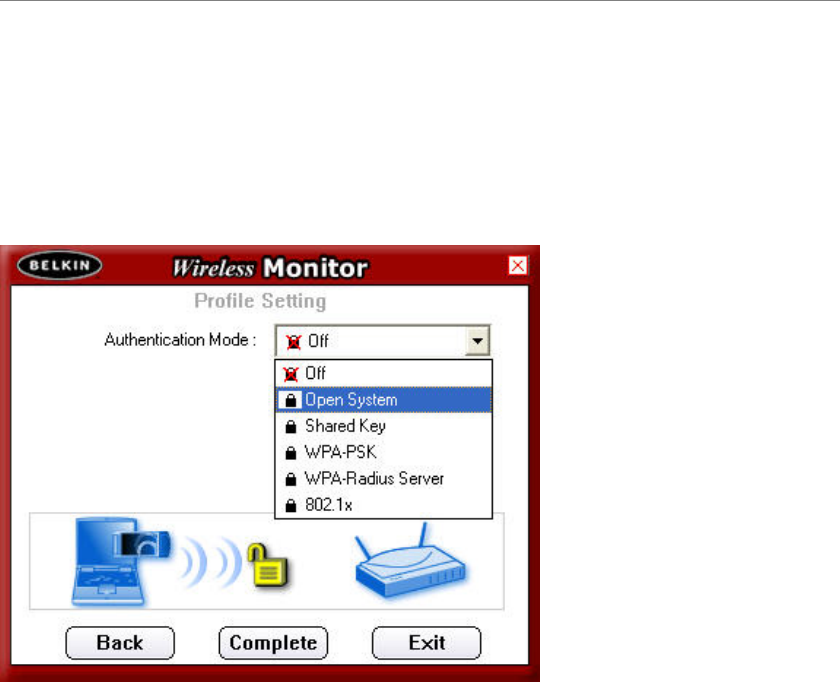
Using the Belkin Wireless LAN Monitor Utility
Configuring your Belkin Wireless Adapter to Use Security
At this point, you should already have your wireless router or access point set to use WPA or WEP (see “Securing your Wi-Fi Network”
section of this manual). In order for you to gain wireless connection, you will need to set your adapter to use the same security settings.
Connecting to a Wireless Network using 64-Bit or 128-Bit WEP:
To enable the security settings for the adapter, you must select a network from the “Available Networks” tab or a profile from the
“Profiles” tab and follow steps 1-4 in “Profile tabs” section before continuing..
Step 1. Select either “Open System” or “Shared Key” from the “Authentication Mode” drop-down box. Most networks with WEP use
“Open System” key type.
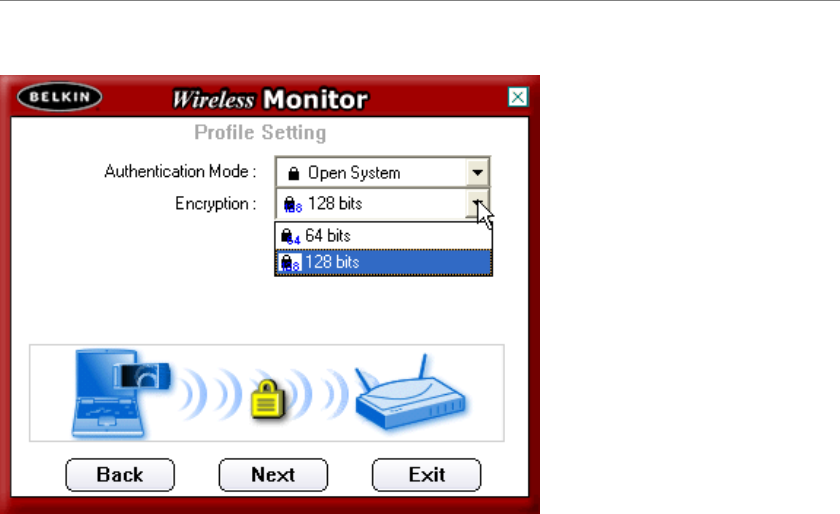
Using the Belkin Wireless LAN Monitor Utility
Step 2. Next, depending on the WEP security settings the router (or access point) you are connecting to may be using, select “64 bits” or
“128 bits” from the “Encryption” drop-down box and click “Next” to continue.
Step 3. The next screen allows you to select the encryption key “Input Method” using alphanumeric, hexadecimal, or passphrase. Most
WEP encryption keys are Hexadecimal consisting of letters A through F and numbers 0 through 9. The method you choose should match
the same method used by the router (or access point). Select the “Input Method”, enter in the key and select 1, 2, 3, or 4 from the “Key
Index”.
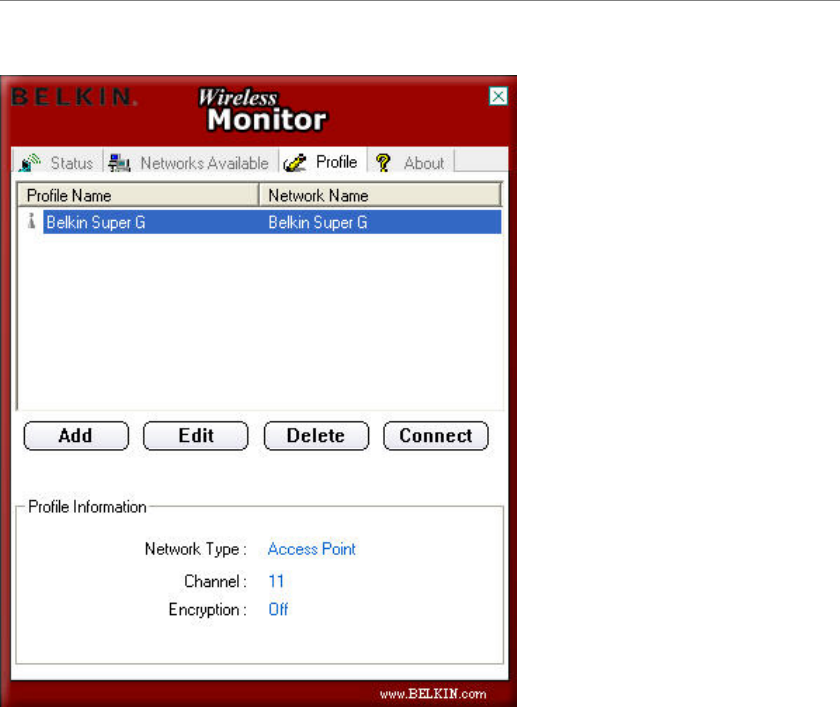
Using the Belkin Wireless LAN Monitor Utility
Step 4. Click “Complete” to save the security settings and the new profile. To begin using your new profile, highlight the profile name
by clicking on the name one time, then click “Connect”.
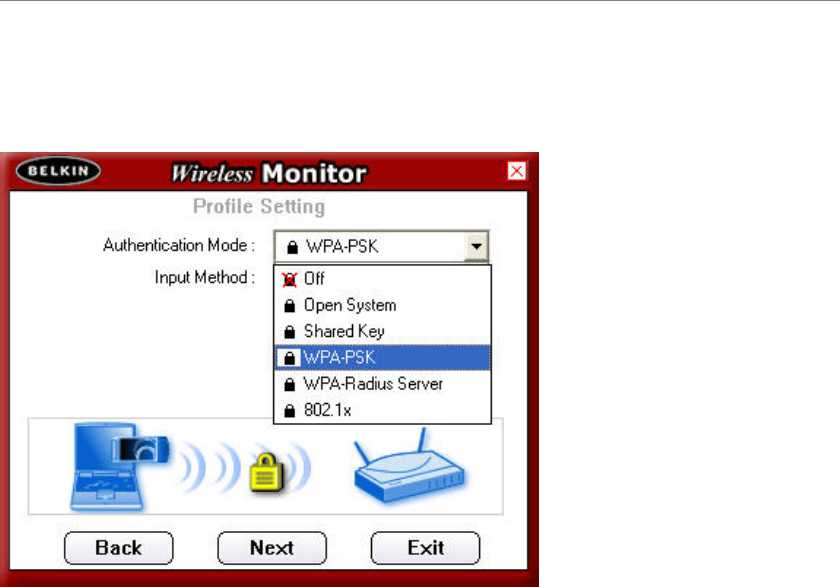
Using the Belkin Wireless LAN Monitor Utility
Connecting to a Wireless Network using WPA-PSK (no server):
To enable the security settings for the adapter, you must select a network from the “Available Networks” tab or a profile from the
“Profiles” tab and follow steps 1-4 of “Profile tab” section before continuing.
Step 1. Select “WPA-PSK” from the “Authentication Mode” drop-down box.

Using the Belkin Wireless LAN Monitor Utility
Step 2. Choose either “TKIP” or “AES” from the “Input Method” drop-down box depending on the WPA-PSK security settings the
router (or access point) you are connecting to may be using. Click “Next” to continue.
Step 3. Next enter the encryption key in the “Key” box. The key should match the key used in the router (or access point).

Using the Belkin Wireless LAN Monitor Utility
Step 4. Click “Complete” to save the security settings and the new profile. To begin using your new profile, highlight the profile name
by clicking on the name one time, then click “Connect”.
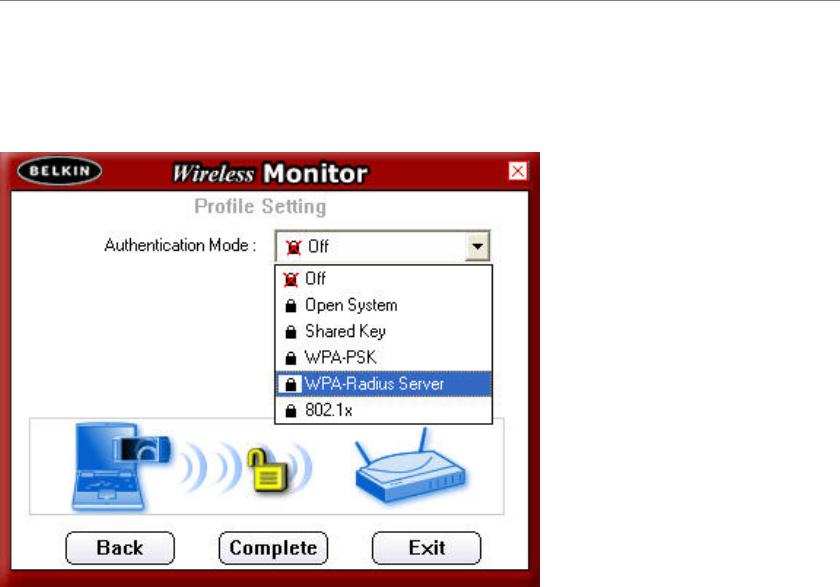
Using the Belkin Wireless LAN Monitor Utility
Connecting to a Wireless Network using WPA-Radius Server or 802.1x:
To enable the security settings for the adapter, you must select a network from the “Available Networks” tab or a profile from the
“Profiles” tab and follow steps 1-4 of “Profile tab” section before continuing.
Step 1. Select “WPA-Radius Server” or “802.1x” from the “Authentication Mode” drop-down box.
Step 2. Select the settings to connect to your router (or access point) as indicated by your network administrator.
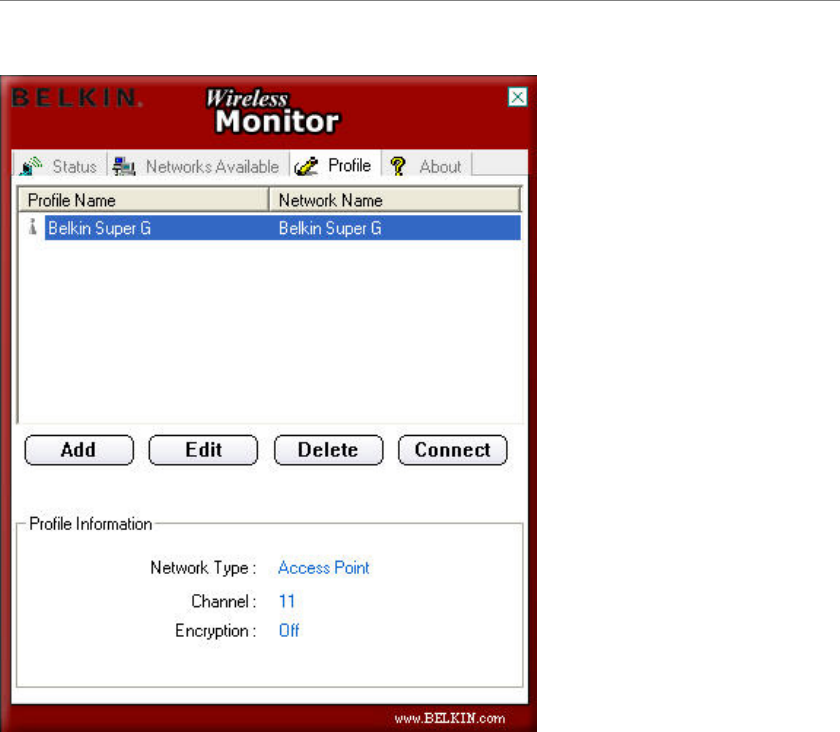
Using the Belkin Wireless LAN Monitor Utility
Step 3. Click “Complete” to save the security settings and the new profile. To begin using your new profile, highlight the profile name
by clicking on the name one time, then click “Connect”.

Troubleshooting
I can’t connect to the Internet wirelessly
If you are unable to connect to the Internet from a wireless computer, please check the following items:
1. Look at the lights on your wireless router. If you’re using a Belkin Wireless Router, the lights should be as follows:
• The “Power” light should be on.
• The “Connected” light should be on, and not blinking.
• The “WAN” light should be either on or blinking.
If your Belkin Wireless Router’s lights have the above characteristics, go to number 2, below.
If this is NOT the case, make sure:
• The Router’s power cord is plugged in.
• All cables are connected between the Router and the modem.
• All the modem’s LEDs are functioning correctly. If not, see your modem’s user manual.
• Reboot the Router.
• Reboot the Modem.
If you continue to have issues, please contact Belkin Technical Support.
If you are not using a Belkin Wireless Router, consult that router manufacturer’s user guide.
2. Open your Wireless Network Utility software by clicking on the icon in the system tray at the bottom right-hand corner of the screen,
the tray icon should look like this (the icon may be red, yellow or green):
3. The Belkin Wireless Network Utility window will display the available networks in the “Available Networks” tab. Available
networks are wireless networks you can connect to.
If you are using a Belkin Dual-Band Wireless A+G Router in 802.11a mode, “Belkin Super A” is the default name.
If you are using a Belkin Dual-Band Wireless A+G Router in 802.11b/g mode, “Belkin Super G” is the default name.
Troubleshooting
If you are using a Belkin 802.11g (125HSM) Router, or Belkin 802.11g (54g) router, “Belkin54g” is the default
name.
If you are using a Belkin 802.11b Router, the default name should be “WLAN”.
If you are using a Belkin Pre-N Router, the default name should be “Belkin pre-N” followed by the serial number
specific to that Router.
If you are NOT using a Belkin Router, please consult your router manufacturer’s user manual for the default name.
The name of your wireless network DOES NOT appear in the list of “Available Networks”
If the correct network name is listed in the “Available Networks”, please follow the steps below to connect
wirelessly:
1. Click on the correct network name in the “Available Networks” to connect to the network.
2. If the network has security (encryption) enabled, you will need to enter the network key.

3.
Within a few seconds, the tray icon in the lower right-hand corner of your screen should turn green, indicating
a successful connection to the network. If you are still unable to access the Internet after connecting to the
wireless network, please contact Belkin Technical Support.
The name of your wireless network DOES NOT appear in the list of “Available Networks”.
If the correct network name is not listed, check the SSID settings to see if they match. The SSID is case-sensitive
and the spelling on each computer must be exactly the same in order for the adapter to connect to the wireless
router or access point.
Note: To check the SSID settings or look for an available network, double-click the “Signal Indicator” icon
to bring up the
Belkin Wireless Network Utility, then click on the “Available Networks” tab. Click on the “Profiles” box if
you do not see the network you are trying to connect to and click “Add”. Then follow the instructions in “Setting
Wireless Network Profiles”
of this manual. For more information about setting up a SSID please reference your router manufacturer’s user
manual.
If issues persist even at close range, please contact Belkin Technical Support.
Installation CD-ROM does not start Setup Utility.
If the CD-ROM does not start the Setup Utility automatically, it could be that the computer is running other
applications that are interfering with the CD drive. If the Setup Utility screen does not appear within 15-20
seconds,
open up your CD-ROM drive by double-clicking on the “My Computer” icon. Next, double-click on the CD-ROM drive
that the Installation CD has been placed in to start the installation. Then double-click on the folder named
“Files”. Next, double-click on the icon named “setup.exe”.
Adapter is not working
If the adapter is not working, the problem may be that the adapter is not connected or installed properly. Verify that the adapter is
plugged firmly into the USB port of your computer. Check to see that the drivers for the adapter have been
Troubleshooting
installed. Right click on the “My Computer” icon on your desktop. Choose “Properties” and navigate to the “Device Manager” and see if
your adapter is listed without any errors. If an error is indicated, please contact Belkin Technical Support.
Link/Activity LED does not come ON; cannot connect to a wireless network or the Internet
If your adapter appears to be functioning properly, but you cannot connect to a network or you have a red wireless icon at the bottom of
your screen, the problem may be that there is a mismatch between the network name (SSID) settings in your wireless network properties.
Check the SSID settings to see if they match. The SSID is case-sensitive and the spelling on each computer must be exactly the same in
order for the adapter to connect to the wireless router or access point.
Note: To check the SSID settings or look for an available network, double-click the “Signal Indicator” icon to bring up the Belkin
Wireless Network Utility then click on the “Available Networks” window. If you do not see the network you are trying to connect to,
click on the “Profiles” tab and type in the “Network Name” box the SSID of the router or access point you are trying to connect to. Then
follow the instructions in the “Setting Wireless Network Profiles” section of this manual.
For more information about setting up an SSID, please reference your router manufacturer’s user manual. If issues persist even at close
range, please contact Belkin Technical Support.
Link/Activity LED is solid but cannot connect to the Internet
If you have a signal but can’t get online or obtain an IP address, the problem may be that there is a mismatch between the encryption key
settings in your computer and wireless router or access point.
Check the WEP key settings to see if they match. The key is case-sensitive and the spelling on each computer and wireless router or
access point must be exactly the same in order for the adapter to connect to the router. For more information about encryption, please see
“Securing your Wi-Fi Network” of this manual.
If issues persist even at close range, please contact Belkin Technical Support.
Data transfer is sometimes slow
Wireless technology is radio-based, which means connectivity and the throughput performance between devices decreases when the
distance between devices increases. Other factors that will cause signal degradation (metal is generally the worst culprit) are obstructions
such as walls and metal appliances. As a result, the typical indoor range of your wireless devices will be between 100 to 200 feet. Note
also that connection speed may decrease as you move farther from the wireless router or access point.

In order to determine if wireless issues are related to range, we suggest temporarily moving the computer, if possible, to five to 10 feet
from the wireless router or access point. If issues persist even at close range, please contact Belkin Technical Support.
Signal strength is poor
Wireless technology is radio-based, which means connectivity and the throughput performance between devices decreases when the
distance between devices increases. Other factors that will cause signal degradation (metal is
Troubleshooting
generally the worst culprit) are obstructions such as walls and metal appliances. As a result, the typical indoor range of your wireless
devices will be between 100 to 200 feet. Note also that connection speed may decrease as you move farther from the wireless router or
access point.
In order to determine if wireless issues are related to range, we suggest temporarily moving the computer, if possible, to five to 10 feet
from the wireless router or access point.
Changing the wireless channel – Depending on local wireless traffic and interference, switching the wireless channel of your network
can improve performance and reliability. You may choose from several other channels depending on your region; see your router or
access point user manual for instructions on how to choose other channels.
If issues persist even at close range, please contact Belkin Technical Support.
Why are there two wireless utilities in my system tray? Which one do we use?
There are several features and advantages of using the Belkin Wireless Network Utility over the Windows XP Wireless Zero
Configuration Utility. We offer link status, detailed link information plus an available networks site survey, to name a few.
It’s essential to know which utility is managing your adapter. We recommend using the Belkin Wireless Network Utility.
To use the Belkin Wireless Network Utility follow the steps below:
Step 1 Right-click on the network status icon in the system tray and select the “Status” tab.
Step 2 From the “Status” tab, uncheck the “Use Windows to configure my wireless network settings” check box. Once the box is
unchecked, click the “Close” button to close the window.
You are now using the Belkin Wireless Network Utility to configure the adapter.
Adapter does not perform or connection is unstable when computer has a second built-in wireless network adapter (such as a
mini PCI or Intel® Centrino™)
This condition occurs if your computer has a built-in wireless adapter while your Belkin Wireless adapter is also active. This happens
because Windows must now handle two active wireless connections.
You need to disable the built-in wireless adapter from your computer under “Network Adapters” in the Device Manager.
Adapter does not perform, or connection is slow when computer has a built-in wired Ethernet adapter
This condition occurs if your computer has an active Ethernet card while your Wireless adapter is also active. This happens because
Windows must now handle two active network connections.
You need to disable the Ethernet adapter from your computer under “Network Adapters” in the Device Manager.
Troubleshooting
What’s the difference between 802.11b, 802.11g and 802.11a, and Pre-N?
Currently there are four levels of wireless networking standards, which transmit data at very different maximum speeds. Each is based on
the designation 802.11(x), so named by the IEEE, the board that is responsible for certifying networking standards. The most common
wireless networking standard, 802.11b, transmits information at 11Mbps; 802.11a and 802.11g work at 54Mbps. Pre-N, the precursor to
the upcoming 802.11n release, promises speeds that exceed 802.11g, and up to twice the wireless coverage area. See the following chart
for more detailed information.
Wireless Comparison Chart
Wireless Technology 802.11b 802.11g 802.11a Belkin Pre-N
Speed 11Mbps 54Mbps 54Mbps 108Mbps
Frequency Common household
devices, such as
cordless
p
hones and
Common household
devices, such as
cordless
p
hones and
5GHz – uncrowded
band Common household
devices such as cordless
p
hones and microwave

microwave ovens may
interfere with the
unlicensed band
2.4GHz
microwave ovens may
interfere with the
unlicensed band
2.4GHz
ovens may interfere
with the unlicensed
band 2.4GHz
Compatibility Compatible with
802.11g Compatible with
802.11b Incompatible with
802.11b or 802.11g Compatible with
802.11g or 802.11b
Coverage Depends on
interference—typically
100-200 ft. indoors
Depends on
interference—typically
100-200 ft. Indoors
Interference range is
typically 50-100ft. 2x the coverage of
standard 802.11g
Adoption Mature—widely
adopted Expected to continue to
grow in popularity Slow adoption for
consumers—more
popular in business
environments
Expected to continue to
grow in popularity

Troubleshooting
Technical Support
You can find technical support information at www.belkin.com/networking. If you want to contact technical support by phone, please
call:
US: 877-736-5771
Europe: 00 800 223 55 460
Australia: 1800 235 546
New Zealand: 0800 235 546
Singapore: 800 616 1790
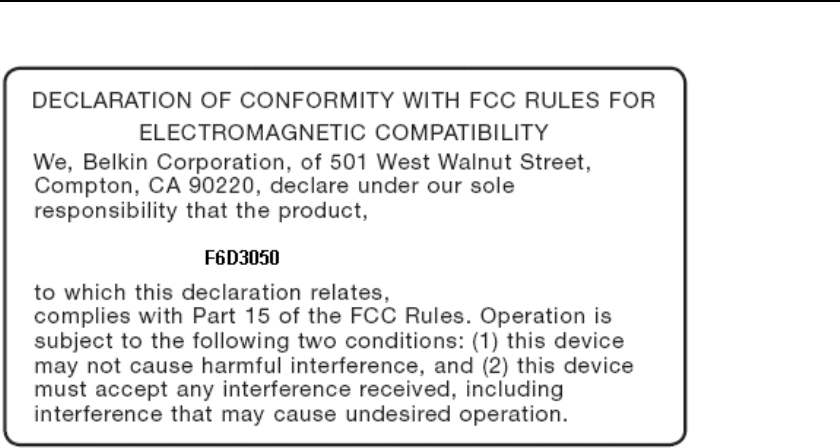
Information
FCC Statement
Belkin declares that F6D3050 (FCC ID:K7S-F6D3050) is limited in CH1~CH11 for 2.4GHz by
specified firmware controlled in U.S.A
This equipment has been tested and found to comply with the limits for a Class B digital device, pursuant to Part 15 of the FCC Rules.
These limits are designed to provide reasonable protection against harmful interference in a residential installation. This equipment
generates, uses and can radiate radio frequency energy and, if not installed and used in accordance with the instructions, may cause
harmful interference to radio communications. However, there is no guarantee that interference will not occur in a particular
installation. If this equipment does cause harmful interference to radio or television reception, which can be determined by turning the
equipment off and on, the user is encouraged to try to correct the interference by one of the following measures:
- Reorient or relocate the receiving antenna.
- Increase the separation between the equipment and receiver.
- Connect the equipment into an outlet on a circuit different from that
to which the receiver is connected.
- Consult the dealer or an experienced radio/TV technician for help.
Modifications
The FCC requires the user to be notified that any changes or modifications to
this device that are not expressly approved by Belkin Corporation may void
the user’s authority to operate the equipment.
IMPORTANT NOTE:
FCC Radiation Exposure Statement:
This equipment complies with FCC radiation exposure limits set forth for an uncontrolled environment. End users must follow the
specific operating instructions for satisfying RF exposure compliance.
For operation within 5.15 ~ 5.25GHz frequency range, it is restricted to indoor environment, and the antenna of this device must be
integral.
This transmitter must not be co-located or operating in conjunction with any other antenna or transmitter.
This equipment has been SAR-evaluated for use in laptops (notebooks) with side slot configuration.
MAXIMUM AVERAGE SAR (1g) (FOR 802.11b) is 0.678W/kg.
MAXIMUM AVERAGE SAR (1g) (FOR 802.11g) is 0.412W/kg.
MAXIMUM AVERAGE SAR (1g) (FOR 802.11a) is 1.310W/kg.

Information
Canada-Industry Canada (IC)
The device is certified to the requirements of RSS-210 for 2.4 GHz spread spectrum devices. To prevent radio interference to the
licensed service (i.e. co-channel Mobile Satellite systems) this device is intended to be operated indoors and away from windows to
provide maximum shielding. Equipment (or its transmit antenna) that is installed outdoors is subject to licensing.
Because high power radars are allocated as primary users (meaning they have priority) in 5250-5350 MHz, these radars could cause
interference and/or damage to license exempt LAN devices.
Operation is subject to the following two conditions:
1) This device may not cause interference and
2) This device must accept any interference, including interference that may cause undesired operation of the device.
The wireless radio of this device complies with RSS 139 & RSS 210 Industry
Canada. This Class B digital apparatus complies with Canadian ICES-003.
Cet appareil numérique de la classe B conforme á la norme NMB-003 du Canada.
Europe-European Union Notice
Radio products with the CE 0682 or CE alert marking
comply with the R&TTE Directive (1995/5/EC) issued by the
Europe-European Union Notice
Radio products with the CE 0682 or CE alert marking
comply with the R&TTE Directive (1995/5/EC) issued by the
Commission of the European Community.
Compliance with this directive implies conformity to the following European
Norms (in brackets are the equivalent international standards).
• EN 60950 (IEC60950) – Product Safety
• EN 300 328 Technical requirement for radio equipment
• ETS 300 826 General EMC requirements for radio equipment.
To determine the type of transmitter, check the identification label

Information
on your Belkin product.
Products with the CE marking comply with the EMC Directive (89/336/EEC)
and the Low Voltage Directive (72/23/EEC) issued by the Commission of the
European Community. Compliance with these directives implies conformity
to the following European Norms (in brackets are the equivalent international
standards).
• EN 55022 (CISPR 22) – Electromagnetic Interference
• EN 55024 (IEC61000-4-2,3,4,5,6,8,11) – Electromagnetic Immunity
• EN 61000-3-2 (IEC610000-3-2) – Power Line Harmonics
• EN 61000-3-3 (IEC610000) – Power Line Flicker
• EN 60950 (IEC60950) – Product Safety
Products that contain the radio transmitter are labeled with CE 0682
or CE alert marking and may also carry the CE logo.

Information
Belkin Corporation Limited Lifetime Product Warranty
Belkin Corporation warrants this product against defects in materials and workmanship for its lifetime. If a defect
is discovered, Belkin will, at its option, repair or replace the product at no charge provided it is returned
during the warranty period, with transportation charges prepaid, to the authorized Belkin dealer from whom you
purchased the product. Proof of
purchase may be required.
This warranty does not apply if the product has been damaged by accident, abuse, misuse, or misapplication; if
the product has been modified without the written permission of Belkin; or if any Belkin serial number has been
removed or defaced.
THE WARRANTY AND REMEDIES SET FORTH ABOVE ARE EXCLUSIVE IN LIEU OF ALL OTHERS, WHETHER ORAL OR WRITTEN, EXPRESSED
OR IMPLIED. BELKIN SPECIFICALLY DISCLAIMS ANY AND ALL IMPLIED WARRANTIES, INCLUDING, WITHOUT LIMITATION,
WARRANTIES OF MERCHANTABILITY AND FITNESS FOR A PARTICULAR PURPOSE.
No Belkin dealer, agent, or employee is authorized to make any modification, extension, or addition to this
warranty.
BELKIN IS NOT RESPONSIBLE FOR SPECIAL, INCIDENTAL, OR CONSEQUENTIAL DAMAGES RESULTING FROM ANY BREACH OF WARRANTY,
OR UNDER ANY OTHER LEGAL THEORY, INCLUDING BUT NOT LIMITED TO, LOST PROFITS, DOWNTIME, GOODWILL, DAMAGE TOOR
REPROGRAMMING OR REPRODUCING ANY PROGRAM OR DATA STORED IN, OR USED WITH, BELKIN PRODUCTS. Some states do not
allow the exclusion or limitation of incidental or consequential damages or exclusions of implied warranties,
so the above limitations or exclusions may not apply to you. This warranty gives you specific legal rights, and
you may also have other rights that vary from state to state.